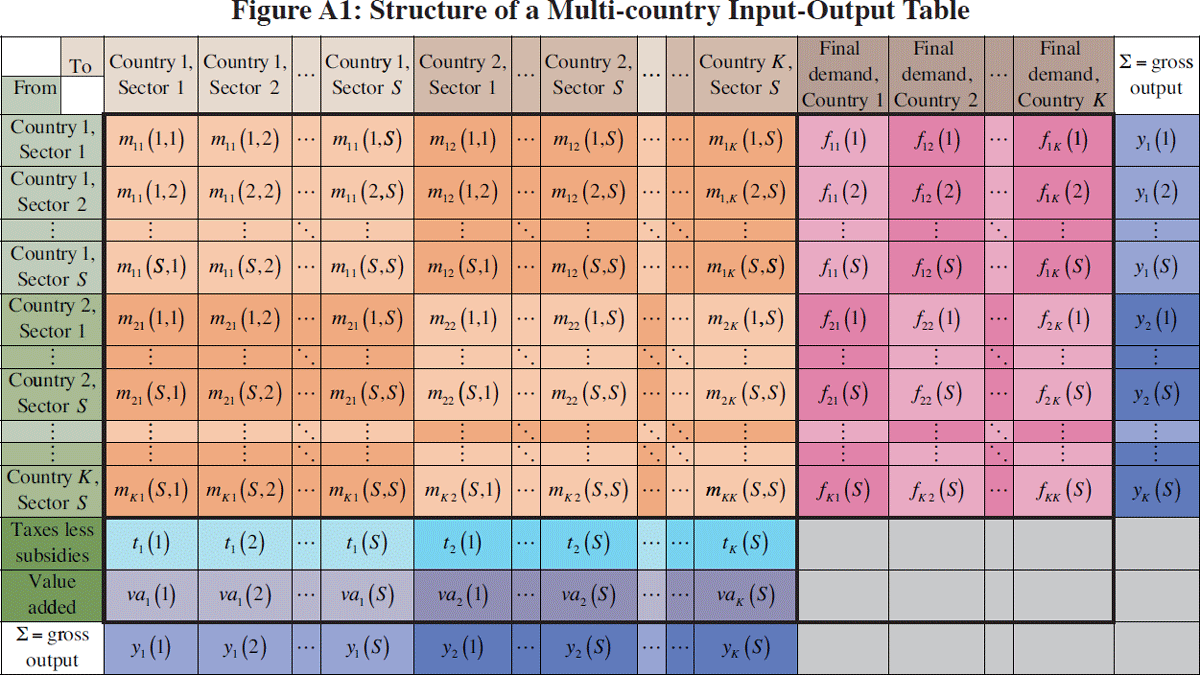RDP 2014-07: International Trade Costs, Global Supply Chains and Value-added Trade in Australia Appendix A: Construction of Value-added Trade Estimates
August 2014 – ISSN 1320-7229 (Print), ISSN 1448-5109 (Online)
- Download the Paper 977KB
This appendix outlines the input-output tables available in the WIOD and describes the construction of the key indicator of value-added trade – the VAX ratio. A multiregional input-output table (Figure A1) extends the traditional concept of an input-output table by concatenating matrices of inter-industry input use and vectors of final demand to record internal and cross-border flows of final and intermediate goods and services. The flows represent values rather than volumes. This implies a common set of prices and ensures the market clearing condition that overall revenue equals expenditure.

The columns of the table represent the inputs used by each industry in each country, with the total value of production equal to the sum of domestic inputs, imported inputs, taxes, margins, and value-added (the contribution of labour and capital). The rows of the table represent the output of each industry in each country, with total output equal to the sum of domestic intermediate use, domestic final use and exports.
Formally, the table entry mij(s, s′) denotes intermediate use of the
output of sector s of country i by sector s′
in country j, while the entry fij (s)
denotes final use of the output of sector s of country i
by country j. Total output of sector s in country i
is denoted  ,
with yi denoting the S ×
1 vector of output for country i's S sectors and fij
denoting the S × 1 vector of country j's final
demand for the output of country i's S sectors.
,
with yi denoting the S ×
1 vector of output for country i's S sectors and fij
denoting the S × 1 vector of country j's final
demand for the output of country i's S sectors.
Total exports of sector s in country i can be denoted xi(s) = Σj≠i fij(s) + Σj≠iΣs′mij(s, s′).
The world input-output table contains information on the approximate technical requirements of production, which means that the value of intermediate inputs used in the k-th step of the production process can be derived from the values of final demand, i.e. those inputs that are used as direct inputs into final demand (first step), those that are used as inputs into those inputs (second step), and so on.
For a table of S sectors in N countries, taking y = (y1,
y2,…, yN)′
to be the SN × 1 vector of total world production, we can write
y = Ay + f, where  is the SN
× 1 vector of total world final demand, and A is the
technical requirements matrix, an SN × SN
matrix with
Aij(s,s′) = mij(s,s′)/yj(s′).
Then
Ak f gives the
value of intermediate inputs used in the k-th step of the production
process.
is the SN
× 1 vector of total world final demand, and A is the
technical requirements matrix, an SN × SN
matrix with
Aij(s,s′) = mij(s,s′)/yj(s′).
Then
Ak f gives the
value of intermediate inputs used in the k-th step of the production
process.
The succession of production stages continues indefinitely due to the ‘circular flow’ of the production process, with the sum of final and intermediate goods and services production converging to the full value of total gross output as the number of stages increases.
A circular production process involving an effectively infinite number of stages,
with identical input requirements and output uses at each stage, is a basic
assumption of input-output analysis. The infinite sum of successive powers
of the technical requirements matrix A converges to  . The matrix (I − A)−1
is the ‘Leontief inverse’, which transforms the final demand vector
into the gross output vector, i.e.
y = (I − A)−1f,
which is simply a rearrangement of y = Ay
+ f.
. The matrix (I − A)−1
is the ‘Leontief inverse’, which transforms the final demand vector
into the gross output vector, i.e.
y = (I − A)−1f,
which is simply a rearrangement of y = Ay
+ f.
By decomposing the final demand vector by region, we can estimate the total value of domestic production that is attributable to final demand in various parts of the world.
Similarly the S × 1 vector of output from country i used to produce
goods in country j (denoted yij)
is derived
as  .
.
The ratio ri(s) of value-added to gross output in sector s of country i is defined as one minus the intermediate consumption share of output; ri(s) = 1 − ΣjΣs′Aji(s′, s).[26] Total value-added exports from country i are then given by vai = Σj≠iΣsvaij(s) where vaij(s) = ri(s)yij(s). This implicitly assumes that the share of value-added to gross output is the same for all products of an industry, regardless of whether the products are exported or not.
The ratio of bilateral value-added to gross exports from sector s of country i to country j is then VAXij(s) = vaijj(s)/xij(s).
Footnote
More precisely, value-added also excludes the value of taxes less subsidies. [26]